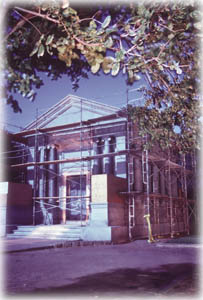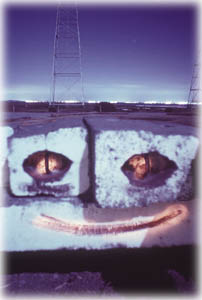![[Best of the Santa Clara Valley 1997]](../gifs/metro-best97.gif)
![[Best of the Santa Clara Valley 1997]](../gifs/metro-best97.gif)
[ 'Best of' Index | Metro | Metroactive Central | Archives ]
Quick, who's buried in Stanford's tomb?
By Dan Pulcrano
The answer should be of at least passing interest to anyone who lives or works around here. Were it not for a 15-year-old's premature death in 1884, we would not be enjoying the fruits of the world's strongest economy. Leland Stanford Jr.'s tragic demise in Paris that year of typhoid fever inspired his railroad baron dad to found and endow the university that spawned Silicon Valley, without which we might still be drying apricots.
Or something.
To express our appreciation for that fact, we commissioned noted art photographer Karekin Goekjian of Athens, Ga., to spend three moonlit nights last month photographing Silicon Valley landmarks. He captured this image of the Stanford Family Mausoleum, where young Leland Stanford and his parents lie beneath granite and scaffolding while the monument undergoes restoration.
Painting his time-lapse exposures with flashlights and strobes, Goekjian also pointed his four Nikons at The Point, a public art piece at the bay's edge, where a vandal has thoughfully added a smile. In creating the cover to this issue of Metro, designer Conor Mangat skillfully merged that image with one of the huge satellite dish that welcomes southbound visitors to Santa Clara County on highway 280.
Like the face that smiles over the bay and electronic systems that watch the skies above, this newspaper's staff annually scans the valley for the interesting, the unusual and the noteworthy. And even though we've been at it for a dozen years, we never fail to be amazed by just how many cool things this area has to offer.
You'll also find a portfolio of panoramic shots by chief photographer Christopher Gardner and the results of our annual reader's survey in this 200-printed-page Metro, the largest ever. We modestly hope it's our best effort as well.
Greater Sphere
Just 2000 paces up from where Alpine Road meets Piers Lane, right off the Portola Road exit on Interstate 280, is a moderately steep trail paved in broken asphalt. Many locals walk or jog here, ignored by jays, coveys of doves and the odd woodpecker. A cyclone fence with three strands of barbed wire surrounds a square of scotch broom and wild oats. There's one other thing in the yard. You can't miss it. It's seven stories tall.
For all of its presence, the Parabolic Reflector Antenna doesn't have a proper name. So the mark on the wooden sign at the base of the trail, indicating the location of "Big Dish" names the Dish as well as showing where it is. Big Dish is 300,000 pounds, 150 feet in diameter, and was commissioned by the Department of Defense in the early 1960s under the specs of the think tank SRI. It is still U.S. government property, though "under the custodianship" of SRI and Stanford.
"The safest way to express what Big Dish is for," says SRI's Alice Galloway, "is that it's for propagation and phenomenology research."
From SRI's description, you can guess that the Big Dish is our Peace Dividend--an old Cold-War-era DOD sword knocked back into a plowshare. But it's more than that: It's also our Paul Bunyan statue, our World's Largest Ball of Twine. The Big Dish emerges out of the bald brown hills on one of the two main roads into the Santa Clara Valley, almost right on the Santa Clara County line, an enormous, mystifying net, a signpost to a valley full of other half-inexplicable technology.
The other photograph on our cover is "The Point," constructed in 1980 by Richard F. Shirley and John M. Kennedy, set in a partially reclaimed stretch of the bay next to the Palo Alto airport. It stands where the land ends: in a pile of salvaged concrete blocks punctuated by rusted bolts, resting in an oval of sunburnt grass pitted with squirrel holes. Some vandal has painted a smudged smile on its side, underneath two of the eye-like bolt holes. A bronze plaque preserves a poem that suggests contemplating the eternal while admiring the marsh: "O Traveler, pause to ponder here/the message from a greater sphere/ and as boats draw sail into a reddening dusk ... now the cool and dateless spring/From which existence finds beginning."
The two landmarks sum up the contrasts of life in the valley: playfulness and paranoia, boom and bust, nebulousness and practicality, highlands and wetlands, garage-level invention and Washington money poured in by the bushel basket. The Point, cool, windy, alive with the sharp cries of shorebirds, is a few hundred yards from the smoking engines on the packed Bayshore Freeway. The Big Dish, on the fringe of the second biggest city in the state, is built on land nicknamed The Farm. Horses flick their tails and lift their heads as you walk back past them down the hill, but the sound of six lanes of traffic on I-280 course past your ears like the roar of Niagara.
[ Metro | Metroactive Central | Archives ]

Karekin Goekjian
Karekin Goekjian
From the Sept. 18-24, 1997 issue of Metro.